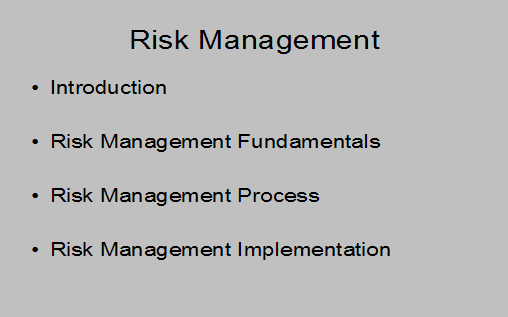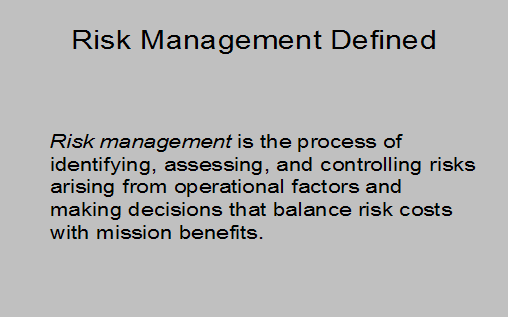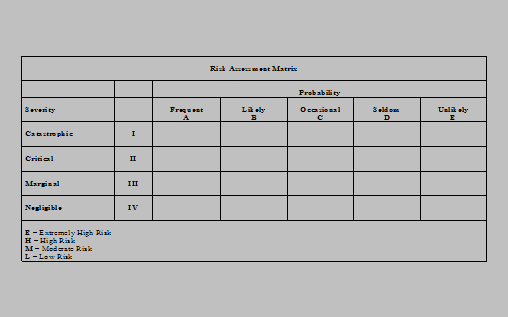Risk Management
Click here to download the presentation.



Risk Management
Introduction
Risk Management Fundamentals
Risk Management Process
Risk Management Implementation
Introduction
FM 100-14 applies across the wide range of Army operations.
It explains the principles, procedures, and responsibilities to successfully apply the risk management process to conserve combat power and resources.
The manual is intended to help all leaders develop a framework to make risk management a routine part of all tasks.
Risk Management Defined
Risk management is the process of identifying, assessing, and controlling risks arising from operational factors and making decisions that balance risk costs with mission benefits.
Fundamentals
Leaders and soldiers at all levels use risk management.
It applies to all missions and environments across the wide range of Army operations.
Principles
Integrating risk management into mission planning, preparation, and execution.
Making risk decisions at the appropriate level in the chain of command.
Accepting no unnecessary risk.
Risk management assists the commander or leader in-
Conserving lives and resources and avoiding unnecessary risk.
Making an informed decision to implement a COA.
Identifying feasible and effective control measures where specific standards do not exist.
Providing reasonable alternatives for mission
accomplishment.
Risk management does not-
Inhibit the commander’s and leader’s flexibility and initiative.
Remove risk altogether, or support a zero defects mindset.
Require a GO/NO-GO decision.
Sanction or justify violating the law.
Remove the necessity for standard drills, tactics, techniques, and procedures.
Risk Management Process
Risk management is the process of identifying and controlling hazards to conserve combat power and resources.
There are 5 steps involved in risk management.
5 Steps of Risk Management
Step 1. Identify hazards.
Step 2. Assess hazards to determine risks.
Step 3. Develop controls and make risk decisions.
Step 4. Implement controls.
Step 5. Supervise and evaluate.
5 Steps of Risk Management
There are 2 types of risks:
1. Tactical risk
2. Accident Risk
Tactical Risk
Tactical risk is risk concerned with hazards that exist because of the presence of either the enemy or an adversary. It applies to all levels of war and across the spectrum of operations.
Accident Risk
Accident risk includes all operational risk considerations other than tactical risk. It includes risks to the friendly force. It also includes risks posed to civilians by an operation, as well as an operations impact on the environment. It can include activities associated with hazards concerning friendly personnel, civilians, equipment readiness, and environmental conditions.
5 Steps (cont)
Steps 1 and 2 together comprise the risk assessment. In Step 1, individuals identify the hazards that may be encountered in executing a mission. In Step 2, they determine the direct impact of each hazard on the operation. The risk assessment provides for enhanced situational awareness. This awareness builds confidence and allows soldiers and units to take timely, efficient, and effective protective measures.
5 Steps (cont)
Steps 3 through 5 are the essential follow-through actions to effectively manage risk. In these steps, leaders balance risk against costs-political, economic, environmental, and to combat power- and take appropriate actions to eliminate unnecessary risk. During execution, as well as during planning and preparation, leaders continuously assess the risk to the overall mission and to those involved in the task. Finally, leaders and individuals evaluate the effectiveness of controls and provide lessons learned so that others
Step 1: Identifying Hazards
Identify hazards to people, property, and mission.
Consider all aspects of past, present, and future problem areas.
Conditions change quickly, consider all METT-TC involved in the operations.
Hazard considerations
Complexity and difficulty of the mission or task.
Terrain and environment.
Weather and visibility.
Equipment on hand and status.
Time available for preparation.
Time available for execution.
Execution Considerations
Supervision
Experience
Training
Morale
Endurance of the soldier
Risk Management Terms
Hazard
Risk
Probability
Severity
Exposure
Controls
Risk assessment
Residual Risk
Hazards
Any existing or potential condition that can cause injury, illness, or death; damage to, or loss of equipment and property; or degradation of the mission.
Risk
The chance of hazards or bad con-sequences; exposure to injury or loss. The risk level is expressed in terms of hazard probability and severity.
Probability
The likeliness that an event will occur.
Frequent-occurs often.
Likely – Occurs several times.
Occasional – occurs sporadically.
Seldom – Unlikely, but could occur.
Unlikely – Probably won’t occur.
Severity
Severity is the expected result of an event (degree of injury, property damage or other mission impairing factors.
Catastrophic
Critical
Marginal
Negligible
Severity
Severity
Severity
Severity
Exposure & Controls
Exposure is the frequency and length of time soldiers, equipment, and missions are subjected to a hazard.
Controls are the actions taken to eliminate or reduce the risks identified.
Risk Assessment
Risk Assessment is the identification and assessments of an individual hazard or all identified hazards combined to complete a task.
Risk Assessment Matrix is often used to estimate the degree of severity and probability for each hazard.
Residual Risk
Residual Risk is the level of risk remaining after controls have been implemented. Controls are altered until the residual risk is at an acceptable level or until it cannot practically be further reduced.
This is for one task.
Overall Residual Risk
Risk Management Implementation
Leaders and soldiers at all levels are responsible and accountable for managing risks by ensuring that hazards and associated risks are –
Identified during planning, preparation, and execution of operations.
Controlled during preparation and execution of operations.
Implementation
Soldiers are responsible for executing risk controls to standards.
They must continuously assess variable hazards such as fatigue, equipment serviceability, and the environment.
They must take care of one another and make risk decisions consistent with the higher commander’s guidance.
Implementation
Risk management is a two-way street.
The objective of managing risk is not to remove all risk, but to eliminate unnecessary risk.
Summary
Identify the hazards.
Assess the hazards to determine risk.
Develop controls and make risk decisions.
Implement controls.
Supervise and refine.
Questions?